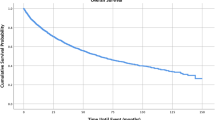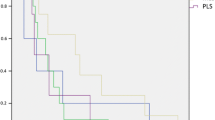Abstract
Purpose
The rarity of infantile fibrosarcoma (IF) has precluded comprehensive treatment evaluation. The purpose of this study was to better define the extent of surgical resection required and the role of chemotherapy.
Methods
Patients (0–2 years) with IF were evaluated from the National Cancer Data Base (1985–2007). Survival was estimated using the Kaplan–Meier method stratifying patients by margin status and treatment with or without chemotherapy.
Results
Of the 224 patients, 171 (76.3 %) were <1 year of age. Of the 64 (28.6 %) with positive margins, 36 (56.3 %) had microscopic disease, 12 (18.8 %) had macroscopic disease, and 16 (25 %) had unknown margin status; none were found to have metastases. Most were managed with surgical resection (171, 76.4 %). The proportion treated with both surgery and chemotherapy increased over time (18–40 %, p = 0.025). Disease-free survival was 90.6 %. No significant survival difference was noted in this retrospective, non-randomized cohort based on margin status, nodal involvement, tumor size, or treatment modality.
Conclusions
The use of multimodal therapy has increased over time. There was a small increase in survival associated with negative margins and the use of multimodal therapy, however, neither result reached significance. Future studies investigating tumor biology and chemosensitivity will likely determine the optimal management of IF.


Similar content being viewed by others
References
Chung EB, Enzinger FM (1976) Infantile fibrosarcoma. Cancer 38(2):729–739
Soule EH, Pritchard DJ (1977) Fibrosarcoma in infants and children: a review of 110 cases. Cancer 40(4):1711–1721
Loh ML et al (2002) Treatment of infantile fibrosarcoma with chemotherapy and surgery: results from the Dana-Farber Cancer Institute and Children’s Hospital. Boston. J Pediatr Hematol Oncol 24(9):722–726
Kurkchubasche AG et al (2000) The role of preoperative chemotherapy in the treatment of infantile fibrosarcoma. J Pediatr Surg 35(6):880–883
Ferguson WS (2003) Advances in the adjuvant treatment of infantile fibrosarcoma. Expert Rev Anticancer Ther 3(2):185–191
Demir HA et al (2010) Right foot congenital infantile fibrosarcoma treated only with chemotherapy. Pediatr Blood Cancer 54(4):618–620
Cecchetto G et al (2001) Fibrosarcoma in pediatric patients: results of the Italian cooperative group studies (1979–1995). J Surg Oncol 78(4):225–231
Hayes-Jordan AA et al (2000) Nonrhabdomyosarcoma soft tissue sarcomas in children: is age at diagnosis an important variable? J Pediatr Surg 35(6):948–953 discussion 953–4
Orbach D et al (2010) Infantile fibrosarcoma: management based on the European experience. J Clin Oncol 28(2):318–323
Russell H et al (2009) Infantile fibrosarcoma: clinical and histologic responses to cytotoxic chemotherapy. Pediatr Blood Cancer 53(1):23–27
Ries L et al Cancer incidence and survival among children and adolescents: United States SEER program 1975–1995, N.C.I. Cancer Statistics Branch, Editor 1999: Bethesda
National Cancer Data Base (2011) Available from: www.facs.org/cancer/ncdb
Winchester DP et al (2004) The National Cancer Data Base: a clinical surveillance and quality improvement tool. J Surg Oncol 85(1):1–3
Bilimoria KY et al (2008) The National Cancer Data Base: a powerful initiative to improve cancer care in the United States. Ann Surg Oncol 15(3):683–690
Raval MV et al (2010) Nodal evaluation in Wilms’ tumors: analysis of the National Cancer Data Base. Ann Surg 251(3):559–565
National Cancer Institute: SEER (2012) Available from: http://seer.cancer.gov
CDC–Cancer–NPCR–program standards (2012) Available from: www.cdc.gov/cancer/npcr/standards.htm
Standards for Cancer Registries: North American Association of Central Cancer Registries (2012) Springfield, IL
International Classification of Diseases for Oncology (2000) Geneva, Switzerland
Grier HE, Perez-Atayde AR, Weinstein HJ (1985) Chemotherapy for inoperable infantile fibrosarcoma. Cancer 56(7):1507–1510
Kynaston JA et al (1993) Chemotherapy in the management of infantile fibrosarcoma. Med Pediatr Oncol 21(7):488–493
Shetty AK et al (1999) Role of chemotherapy in the treatment of infantile fibrosarcoma. Med Pediatr Oncol 33(4):425–427
Sebire NJ et al (2002) Aberrant immunohistochemical expression in nonrhabdomyosarcoma soft tissue sarcomas of infancy: retrospective review of clinical material. Pediatr Dev Pathol 5(6):579–586
Dahl I, Save-Soderbergh J, Angervall L (1973) Fibrosarcoma in early infancy. Pathol Eur 8(3):193–209
Wee A, Pho RW, Ong LB (1979) Infantile fibrosarcoma: report of cases. Arch Pathol Lab Med 103(5):236–238
Cofer BR, Vescio PJ, Wiener ES (1996) Infantile fibrosarcoma: complete excision is the appropriate treatment. Ann Surg Oncol 3(2):159–161
Salloum E et al (1990) Poor prognosis infantile fibrosarcoma with pathologic features of malignant fibrous histiocytoma after local recurrence. Med Pediatr Oncol 18(4):295–298
McCahon E et al (2003) Non-resectable congenital tumors with the ETV6-NTRK3 gene fusion are highly responsive to chemotherapy. Med Pediatr Oncol 40(5):288–292
Ortega-Garcia JA et al (2012) Congenital fibrosarcoma and history of prenatal exposure to petroleum derivatives. Pediatrics 130(4):e1019–e1025
Conflict of interest
The authors have no disclosures.
Author information
Authors and Affiliations
Corresponding author
Rights and permissions
About this article
Cite this article
Sulkowski, J.P., Raval, M.V. & Browne, M. Margin status and multimodal therapy in infantile fibrosarcoma. Pediatr Surg Int 29, 771–776 (2013). https://doi.org/10.1007/s00383-013-3318-4
Accepted:
Published:
Issue Date:
DOI: https://doi.org/10.1007/s00383-013-3318-4




